A Rigid–Flexible and Multi-Siloxane Bridge Strategy for Toughening Epoxy Resin with Promising Flame Retardancy, Mechanical, and Dielectric Properties
Abstract
:1. Introduction
2. Results and Discussion
2.1. Characterization of the Structure of DPB
2.2. Thermal Properties of DPB/EP
2.3. Combustion Behavior of DPB/EP
2.4. Analysis of the Flame-Retardant Mechanism of DPB/EP
2.4.1. Gas Phase Analysis
2.4.2. Condensed Phase Analysis
2.4.3. Flame Retardancy Mechanism
2.5. Dielectric Properties
2.6. Mechanical Properties of DPB/EP
3. Methods and Materials
3.1. Materials
3.2. Synthesis of DPB
3.3. Preparation of DPB/EP Composite
3.4. Characterization
4. Conclusions
Author Contributions
Funding
Institutional Review Board Statement
Informed Consent Statement
Data Availability Statement
Conflicts of Interest
References
- Battig, A.; González, K.I.G.; Schartel, B. Valorizing “non-vegan” bio-fillers: Synergists for phosphorus flame retardants in epoxy resins. Polym. Degrad. Stab. 2022, 198, 109875. [Google Scholar] [CrossRef]
- Jian, X.Y.; He, Y.; Li, Y.D.; Wang, M.; Zeng, J.B. Curing of epoxidized soybean oil with crystalline oligomeric poly (butylene succinate) towards high performance and sustainable epoxy resins. Chem. Eng. J. 2017, 326, 875–885. [Google Scholar] [CrossRef]
- Gu, H.B.; Ma, C.; Gu, J.W.; Guo, J.; Yan, X.R.; Huang, J.N.; Zhang, Q.Y.; Guo, Z.H. An overview of multifunctional epoxy nanocomposites. J. Mater. Chem. C 2016, 4, 5890–5906. [Google Scholar] [CrossRef]
- Aghabararpour, M.; Naderi, M.; Motahari, S.; Najafi, M. A study on resorcinol formaldehyde carbon aerogel/epoxy nanocomposites: The effect of carbon aerogel pyrolysis time. J. Polym. Res. 2019, 26, 59. [Google Scholar] [CrossRef]
- Wan, J.T.; Bu, Z.Y.; Xu, C.J.; Li, B.G.; Fan, H. Preparation, curing kinetics, and properties of a novel low-volatile starlike aliphatic-polyamine curing agent for epoxy resins. Chem. Eng. J. 2011, 171, 357–367. [Google Scholar] [CrossRef]
- Luda, M.P.; Balabanovich, A.I.; Camino, G. Thermal decomposition of fire retardant brominated epoxy resins. J. Anal. Appl. Pyrol. 2002, 65, 25–40. [Google Scholar] [CrossRef]
- Martín, C.; Lligadas, G.; Ronda, J.C.; Galià, M.; Cádiz, V. Synthesis of novel boron containing epoxy–novolac resins and properties of cured products. J. Polym. Sci. Part A Polym. Chem. 2006, 44, 6332–6344. [Google Scholar] [CrossRef]
- Yang, W.M.; Wu, S.Y.; Yang, W.; Yuen, A.C.Y.; Zhou, Y.; Yeoh, G.; Boyer, C.; Wang, C.H. Nanoparticles of polydopamine for improving mechanical and flame-retardant properties of an epoxy resin. Compos. Part B-Eng. 2020, 186, 107828. [Google Scholar] [CrossRef]
- Peng, C.H.; Chen, T.; Zeng, B.; Chen, G.R.; Yuan, C.H.; Xu, Y.T.; Dai, L.Z. Anderson-type polyoxometalate-based hybrid with high flame retardant efficiency for the preparation of multifunctional epoxy resin nanocomposites. Compos. Part B-Eng. 2020, 186, 10778. [Google Scholar] [CrossRef]
- Qian, X.D.; Song, L.; Bihe, Y.; Yu, B.; Shi, Y.Q.; Hu, Y.; Yuen, R.K.K. Organic/inorganic flame retardants containing phosphorus, nitrogen and silicon: Preparation and their performance on the flame retardancy of epoxy resins as a novel intumescent flame retardant system. Mater. Chem. Phys. 2014, 143, 1243–1252. [Google Scholar] [CrossRef]
- Khalili, P.; Tshai, K.Y.; Hui, D.; Kong, I. Synergistic of ammonium polyphosphate and alumina trihydrate as fire retardants for natural fiber reinforced epoxy composite. Compos. Part B-Eng. 2017, 114, 101–110. [Google Scholar] [CrossRef]
- Jiao, C.M.; Zhang, C.J.; Dong, J.; Chen, C.L.; Qian, Y.; Li, S.X. Combustion behavior and thermal pyrolysis kinetics of flame-retardant epoxy composites based on organic-inorganic intumescent flame retardant. J. Therm. Anal. Calorim. 2015, 119, 1759–1767. [Google Scholar] [CrossRef]
- Bourbigot, S.; Bras, M.L.; Duquesne, S.; Rochery, M. Recent advances for intumescent polymers. Macromol. Mater. Eng. 2004, 289, 499–511. [Google Scholar] [CrossRef]
- Zhao, X.; Gao, S.; Liu, G.S. A THEIC-based polyphosphate melamine intumescent flame retardant and its flame retardancy properties for polylactide. J. Anal. Appl. Pyrol. 2016, 122, 24–34. [Google Scholar] [CrossRef]
- Shao, Z.B.; Zhang, J.; Jian, R.K.; Sun, C.C.; Li, X.L.; Wang, D.Y. A strategy to construct multifunctional ammonium polyphosphate for epoxy resin with simultaneously high fire safety and mechanical properties. Compos. Part A-Appl. Sci. Manuf. 2021, 149, 106529. [Google Scholar] [CrossRef]
- Qin, P.F.; Yi, D.Q.; Hao, J.W.; Ye, X.M.; Gao, M.; Song, T.L. Fabrication of melamine trimetaphosphate 2D supermolecule and its superior performance on flame retardancy, mechanical and dielectric properties of epoxy resin. Compos. Part B-Eng. 2021, 225, 109269. [Google Scholar] [CrossRef]
- Cao, C.F.; Yu, B.; Guo, B.F.; Hu, W.J.; Sun, F.N.; Zhang, Z.H.; Li, S.N.; Wu, W.; Tang, L.C.; Song, P.; et al. Bio-inspired, sustainable and mechanically robust graphene oxide-based hybrid networks for efficient fire protection and warning. Chem. Eng. J. 2022, 439, 134516. [Google Scholar] [CrossRef]
- He, S.; Gao, Y.Y.; Zhao, Z.Y.; Huang, S.C.; Chen, Z.X.; Deng, C.; Wang, Y.Z. Fully bio-based phytic acid-basic amino acid salt for flame-retardant polypropylene. ACS Appl. Polym. Mater. 2021, 3, 1488–1498. [Google Scholar] [CrossRef]
- Ding, H.; Wang, J.; Wang, C.; Chu, F. Synthesis of a novel phosphorus and nitrogen-containing bio-based polyols and its application in flame retardant polyurethane sealant. Polym. Degrad. Stab. 2016, 124, 43–50. [Google Scholar] [CrossRef]
- Lee, K.Y.; Mooney, D.J. Alginate: Properties and biomedical applications. Prog. Polym. Sci. 2012, 37, 106–126. [Google Scholar] [CrossRef]
- Costes, L.; Laoutid, F.; Aguedo, M.; Richel, A.; Brohez, S.; Delvosalle, C.; Dubois, P. Phosphorus and nitrogen derivatization as efficient route for improvement of lignin flame retardant action in PLA. Eur. Polym. J. 2016, 84, 652–667. [Google Scholar] [CrossRef]
- Cheng, C.; Wang, Y.; Lu, Y.L.; Li, S.J.; Li, H.; Yan, J.; Du, S.G. Bio-based arginine surface-modified ammonium polyphosphate: An efficient intumescent flame retardant for epoxy resin. RSC Adv. 2022, 12, 9223. [Google Scholar] [CrossRef] [PubMed]
- Zhang, J.; Li, Z.; Yin, G.Z.; Wang, D.Y. Construction of a novel three-in-one biomass based intumescent fire retardant through phosphorus functionalized metal-organic framework and β-cyclodextrin hybrids in achieving fire safe epoxy. Compos. Commun. 2021, 23, 100594. [Google Scholar] [CrossRef]
- Li, X.L.; Zhang, F.H.; Jian, R.K.; Ai, Y.F.; Ma, J.L.; Hui, G.J.; Wang, D.Y. Influence of eco-friendly calcium gluconate on the intumescent flame-retardant epoxy resin: Flame retardancy, smoke suppression and mechanical properties. Compos. Part B-Eng. 2019, 176, 107200. [Google Scholar] [CrossRef]
- Li, X.D.; Liu, X.Q.; Liu, H.Y.; Liu, H.Y.; He, R.; Wang, F.; Meng, S.Y.; Li, Z.M. The low-k epoxy/cyanate nanocomposite modified with epoxy-based POSS: The effect of microstructure on dielectric properties. React. Funct. Polym. 2023, 184, 105522. [Google Scholar] [CrossRef]
- Bonnet, A.; Pascault, J.P.; Sautereau, H.; Rogozinski, J.; Kranbuehl, D. Epoxy-diamine thermoset/thermoplastic blends: Dielectric properties before; during, and after phase separation. Macromolecules 2000, 33, 3833–3843. [Google Scholar] [CrossRef]
- Na, T.Y.; Jiang, H.; Liu, X.; Zhao, C.J. Preparation and properties of novel fluorinated epoxy resins cured with 4-trifluoromethyl phenylbenzimidazole for application in electronic materials. Eur. Polym. J. 2018, 100, 96–102. [Google Scholar] [CrossRef]
- Rashid, M.A.; Zhu, S.Y.; Jiang, Q.R.; Wei, Y.; Liu, W.S. Developing easy processable, recyclable, and self-healable biobased epoxy resin through dynamic covalent imine bonds. ACS Appl. Polym. Mater. 2023, 5, 279–289. [Google Scholar] [CrossRef]
- Rashid, M.A.; Zhu, S.Y.; Zhang, L.Y.; Jin, K.J.; Liu, W.S. High-performance and fully recyclable epoxy resins cured by imine-containing hardeners derived from vanillin and syringaldehyde. Eur. Polym. J. 2023, 187, 111878. [Google Scholar] [CrossRef]
- Yang, W.J.; Ding, H.; Zhou, W.; Liu, T.X.; Xu, P.W.; Puglia, D.; Kenny, J.M.; Ma, P.M. Design of inherent fire retarding and degradable bio-based epoxy vitrimer with excellent self-healing and mechanical reprocess ability. Compos. Sci. Technol. 2022, 230, 109776. [Google Scholar] [CrossRef]
- Wang, P.; Chen, L.; Xiao, H. Flame retardant effect and mechanism of a novel DOPO based tetrazole derivative on epoxy resin. J. Anal. Appl. Pyrol. 2019, 139, 104–113. [Google Scholar] [CrossRef]
- Veen, I.V.D.; Boer, J.D. Phosphorus flame retardants: Properties, production, environmental occurrence, toxicity and analysis. Chemosphere 2012, 88, 1119–1153. [Google Scholar] [CrossRef] [PubMed]
- Zhang, W.; Li, X.; Li, L.; Yang, R. Study of the synergistic effect of silicon and phosphorus on the blowing-out effect of epoxy resin composites. Polym. Degrad. Stab. 2012, 97, 1041–1048. [Google Scholar] [CrossRef]
- Yu, M.; Zhang, T.T.; Li, J.; Tan, J.H.; Zhang, M.; Zhou, Y.H.; Zhu, X.B. Facile synthesis of eugenol-based phosphorus/silicon-containing flame retardant and its performance on fire retardancy of epoxy resin. ACS Appl. Polym. Mater. 2022, 4, 1794–1804. [Google Scholar] [CrossRef]
- Chen, M.F.; Lin, X.H.; Liu, C.P.; Zhang, H.G. An effective strategy to enhance the flame retardancy and mechanical properties of epoxy resin by using hyperbranched flame retardant. J. Mater. Sci. 2021, 56, 5956–5974. [Google Scholar] [CrossRef]
- Chen, M.J.; Lin, Y.C.; Wang, X.N.; Zhong, L.; Li, Q.L.; Liu, Z.G. Influence of cuprous oxide on enhancing the flame retardancy and smoke suppression of epoxy resins containing microencapsulated ammonium polyphosphate. Ind. Eng. Chem. Res. 2015, 54, 12705–12713. [Google Scholar] [CrossRef]
- Lu, X.Y.; Gu, X.L. Fabrication of a bi-hydroxyl-bi-DOPO compound with excellent quenching and charring capacities for lignin-based epoxy resin. Int. J. Biol. Macromol. 2022, 205, 539–552. [Google Scholar] [CrossRef]
- Qiu, Y.; Liu, Z.; Qian, L.J.; Hao, J.W. Pyrolysis and flame retardant behavior of a novel compound with multiple phosphaphenanthrene groups in epoxy thermosets. J. Anal. Appl. Pyrol. 2017, 127, 23–30. [Google Scholar] [CrossRef]
- Yan, L.; Xu, Z.S.; Deng, N.; Chu, Z.Y. Synergistic effects of mono-component intumescent flame retardant grafted with carbon black on flame retardancy and smoke suppression properties of epoxy resins. J. Therm. Anal. Calorim. 2019, 138, 915–927. [Google Scholar] [CrossRef]
- Hu, Q.; Peng, P.R.; Peng, S.; Liu, J.Y.; Liu, X.Q.; Zou, L.Y.; Chen, J. Flame-retardant epoxy resin based on aluminum monomethylphosphinate. J. Therm. Anal. Calorim. 2017, 128, 201–210. [Google Scholar] [CrossRef]
- Hu, B.; Wang, J.; Wang, J.S.; Yang, S.; Li, C.; Wang, F.Y.; Huo, S.Q.; Song, P.G.; Fang, Z.P.; Wang, H. Flame-retardant single-component epoxy resin cured by benzimidazolyl-substituted cyclotriphosphazene: Storage stability, curing behaviors and flame retardancy. Polym. Degrad. Stab. 2022, 204, 110092. [Google Scholar] [CrossRef]
- Zhao, C.S.; Jiang, Y.S.; Liu, Z.Y.; Peng, H.Q.; Esmaeili, N. Synergistic action of expandable graphite on fire safety of a self-intumescent flame retardant epoxy resin. J. Appl. Polym. Sci. 2023, 140, e53425. [Google Scholar] [CrossRef]
- Wang, J.S.; Huo, S.Q.; Wang, J.; Yang, S.; Chen, K.W.; Li, C.; Fang, D.; Fang, Z.P.; Song, P.G.; Wang, H. Green and facile synthesis of bio-based, flame-retardant, latent imidazole curing agent for single-component epoxy resin. ACS Appl. Polym. Mater. 2022, 4, 3564–3574. [Google Scholar] [CrossRef]
- Ma, C.; Yu, B.; Hong, N.N.; Pan, Y.; Hu, W.Z.; Hu, Y. Facile synthesis of a highly efficient, halogen-free, and intumescent flame retardant for epoxy resins: Thermal properties, combustion behaviors, and flame-retardant mechanisms. Ind. Eng. Chem. Res. 2016, 55, 10868–10879. [Google Scholar] [CrossRef]
- Yan, L.; Xu, Z.S.; Wang, X.H.; Deng, N.; Chu, Z.Y. Preparation of a novel mono-component intumescent flame retardant for enhancing the flame retardancy and smoke suppression properties of epoxy resin. J. Therm. Anal. Calorim. 2018, 134, 1505–1519. [Google Scholar] [CrossRef]
- Zhu, Z.M.; Wang, L.X.; Dong, L.P. Influence of a novel P/N-containing oligomer on flame retardancy and thermal degradation of intumescent flame-retardant epoxy resin. Polym. Degrad. Stab. 2019, 162, 129–137. [Google Scholar] [CrossRef]
- Yang, Y.X.; Li, Z.; Wu, G.; Chen, W.; Huang, G.Y. A novel biobased intumescent flame retardant through combining simultaneously char-promoter and radical-scavenger for the application in epoxy resin. Polym. Degrad. Stab. 2022, 196, 109841. [Google Scholar] [CrossRef]
- Xu, Y.; Liu, L.B.; Yan, C.T.; Hong, Y.K.; Xu, M.J.; Qian, L.J.; Li, B. Eco-friendly phosphonic acid piperazine salt toward high-efficiency smoke suppression and flame retardancy for epoxy resins. J. Mater. Sci. 2021, 56, 16999–17010. [Google Scholar] [CrossRef]
- Zhang, W.C.; He, X.D.; Song, T.L.; Jiao, Q.J.; Yang, R.J. Comparison of intumescence mechanism and blowing-out effect in flame-retarded epoxy resins. Polym. Degrad. Stab. 2015, 112, 43–51. [Google Scholar] [CrossRef]
- Qiao, H.W.; Su, L.P.; Liu, C.P.; Zhang, H.G.; Chen, M.F. From laboratory to industrialization: Eco-friendly flame retardant endowing epoxy resin with excellent flame retardancy, transparency, and mechanical properties. Polym. Adv. Technol. 2022, 33, 1695–1705. [Google Scholar] [CrossRef]
- Wang, J.J.; Yu, X.J.; Dai, S.S.; Wang, X.Y.; Pan, Z.Q.; Zhou, H. Synergistic effect of chitosan derivative and DOPO for simultaneous improvement of flame retardancy and mechanical property of epoxy resin. Cellulose 2022, 29, 907–925. [Google Scholar] [CrossRef]
- Lv, J.J.; Chen, B.; Zheng, B.T.; Chen, M.F.; Qiao, H.W.; Li, S.S.; Zhang, H.G. Poly(phosphorus-silicon-alkyne): Widening the application potential in epoxy resin with excellent flame retardancy, mechanical property and unimpaired thermal stability. J. Appl. Polym. Sci. 2022, 139, e52896. [Google Scholar] [CrossRef]
- Zhang, N.; Zhang, J.; Yan, H.; Guo, X.; Sun, Q.; Guo, R. A novel organic-inorganic hybrid K-HBPE@APP performing excellent flame retardancy and smoke suppression for polypropylene. J. Hazard. Mater. 2019, 373, 856–865. [Google Scholar] [CrossRef] [PubMed]
- Wu, W.; Zhao, W.; Gong, X.; Sun, Q.; Cao, X.; Su, Y.; Yu, B.; Li, R.K.Y.; Vellaisamy, R.A.L. Surface decoration of Halloysite nanotubes with POSS for fire-safe thermoplastic polyurethane nanocomposites. J. Mater. Sci. Technol. 2022, 101, 107–117. [Google Scholar] [CrossRef]
- Yuan, B.; Hu, Y.; Chen, X.; Shi, Y.; Niu, Y.; Zhang, Y.; He, S.; Dai, H. Dual modification of graphene by polymeric flame retardant and Ni (OH)2 nanosheets for improving flame retardancy of polypropylene. Compos. Part A-Appl. Sci. Manuf. 2017, 100, 106–117. [Google Scholar] [CrossRef]
- Khanal, S.; Lu, Y.H.; Dang, L.; Ali, M.; Xu, S.A. Effects of α-zirconium phosphate and zirconium organophosphonate on the thermal, mechanical and flame retardant properties of intumescent flame-retardant high-density polyethylene composites. RSC Adv. 2020, 81, 106177. [Google Scholar] [CrossRef]
- Li, C.; Fan, H.; Aziz, T.; Bittencourt, C.; Wu, L.B.; Wang, D.Y.; Dubois, P. Biobased epoxy resin with low electrical permissivity and flame retardancy: From environmentally friendly high-throughput synthesis to properties. ACS Sustain. Chem. Eng. 2018, 6, 8856–8867. [Google Scholar] [CrossRef]
- Wan, J.T.; Zhao, J.Q.; Gan, B.; Li, C.; Molina-Aldareguia, J.; Zhao, Y.; Pan, Y.T.; Wang, D.Y. Ultra stiff biobased epoxy resin with high Tg and low permittivity: From synthesis to properties. ACS Sustain. Chem. Eng. 2016, 4, 2869–2880. [Google Scholar] [CrossRef]
- Li, S.C.; Chen, D.; Yuan, Y.H.; Gao, C.; Cui, Y.G.; Wang, H.Y.; Liu, X.; Liu, M.J.; Wu, Z.J. Influence of flexible molecular structure on the cryogenic mechanical properties of epoxy matrix and carbon fiber/epoxy composite laminate. Mater. Des. 2020, 195, 109028. [Google Scholar] [CrossRef]
- Bao, Q.; Wang, B.; Liu, Y.; Wang, Q.; Yang, Z.Q. Epoxy resin flame retarded and toughed via flexible siloxane chain containing phosphaphenanthrene. Polym. Degrad. Stab. 2020, 172, 109055. [Google Scholar] [CrossRef]
- Chen, B.; Luo, W.H.; Lv, J.J.; Lin, S.F.; Zheng, B.T.; Zhang, H.G.; Chen, M.F. A universal strategy toward flame retardant epoxy resin with ultra-tough and transparent properties. Polym. Degrad. Stab. 2022, 205, 110132. [Google Scholar] [CrossRef]
- Liu, H.C.; Gao, X.X.; Deng, B.; Huang, G.S. Simultaneously reinforcing and toughening epoxy network with a novel hyperbranched polysiloxane modifier. J. Appl. Polym. Sci. 2018, 135, 46340. [Google Scholar] [CrossRef]
- Ma, C.; Qiu, S.L.; Yu, B.; Wang, J.L.; Wang, C.M.; Zeng, W.R.; Hu, Y. Economical and environment-friendly synthesis of a novel hyperbranched poly (aminomethylphosphine oxide-amine) as co-curing agent for simultaneous improvement of fire safety, glass transition temperature and toughness of epoxy resins. Chem. Eng. J. 2017, 322, 618–631. [Google Scholar] [CrossRef]
- Zhuo, D.X.; Gu, A.J.; Liang, G.Z.; Hu, J.T.; Yuan, L.; Chen, X.X. Flame retardancy materials based on a novel fully end-capped hyperbranched polysiloxane and bismaleimide/diallylbisphenol a resin with simultaneously improved integrated performance. J. Mater. Chem. 2011, 21, 6584–6594. [Google Scholar] [CrossRef]
- Gao, M.; Chen, S.; Wang, H.; Chai, Z.H. Design; preparation, and application of a novel, microencapsulated, intumescent, flame-retardant-based mimicking mussel. ACS Omega 2018, 3, 6888–6894. [Google Scholar] [CrossRef] [PubMed]
- Li, D.S.; Zhang, Z.Y.; Wang, S.Q.; Xu, M.J.; Li, B. A monomolecular intumescent flame retardant for improvement simultaneously of fire safety, smoke suppression, and mechanical properties of epoxy resin. J. Appl. Polym. Sci. 2022, 139, e52104. [Google Scholar] [CrossRef]
- Zhang, J.; Li, Z.; Zhang, L.; Molleja, J.G.; Wang, D.Y. Bimetallic metal-organic framework and graphene oxide nano-hybrids induced carbonaceous reinforcement towards fire retardant epoxy: A novel alternative carbonization mechanism. Carbon 2019, 153, 407–416. [Google Scholar] [CrossRef]
- Jian, R.K.; Ai, Y.F.; Xiao, L.; Zhao, L.J.; Zhao, H.B. Single component phosphamide-based intumescent flame retardant with potential reactivity towards low flammability and smoke epoxy resins. J. Hazard. Mater. 2019, 371, 529–539. [Google Scholar] [CrossRef]
- GB/T 2406.2-2009; Plastics: Determination of Burning Behavior by the Oxygen Index Method Part 2: Room Temperature Test. China Standards Press: Beijing, China, 2009.
- GB/T 2408-2008; Plastics: Determination of Flammability Horizontal and Vertical Methods. China Standards Press: Beijing, China, 2008.
- ISO 5660; Reaction-to-Fire Tests—Heat Release, Smoke Production and Mass Loss Rate. International Organization for Standardization (ISO): Geneva, Switzerland, 2015.
- GB/T 1040.2-2022; Plastics: Determination of Tensile Properties Part 2: Test Conditions for Molded and Extruded Plastics. China Standards Press: Beijing, China, 2022.
- GB/T 9341-2008; Plastics: Determination of Bending Properties. China Standards Press: Beijing, China, 2008.

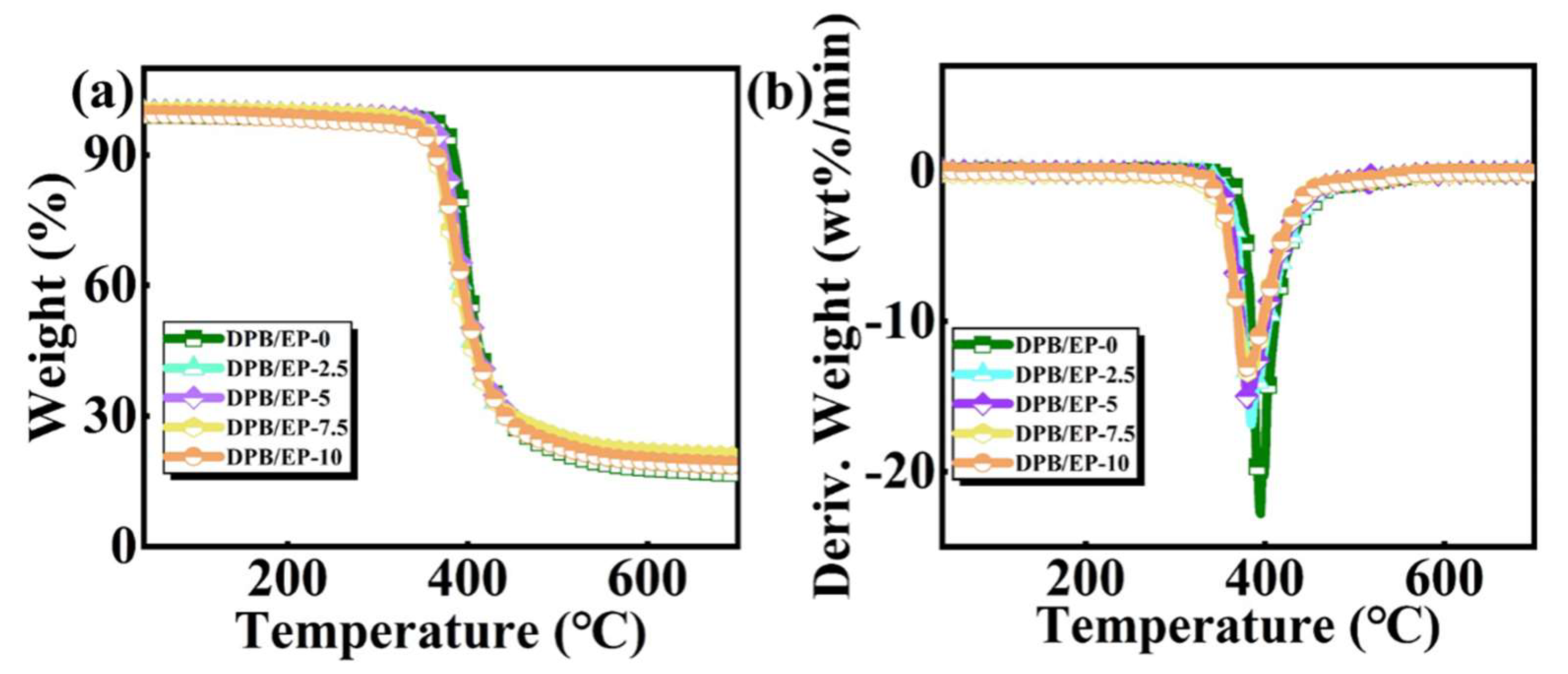


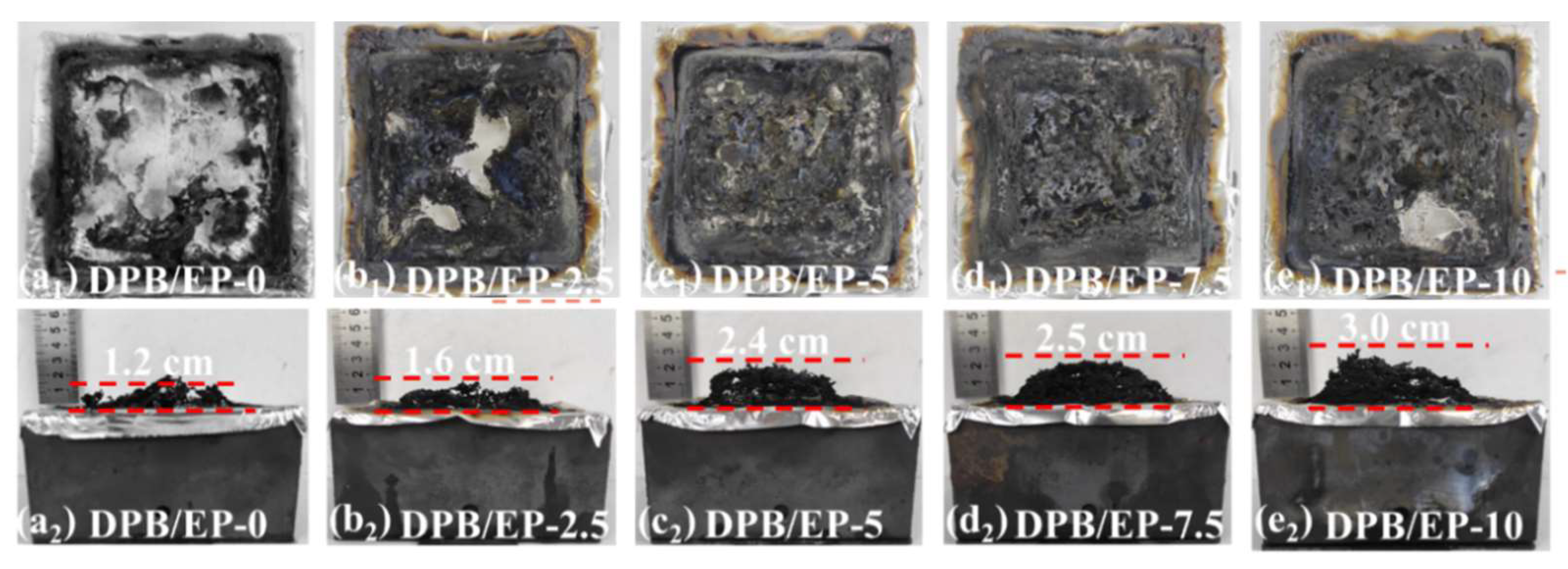

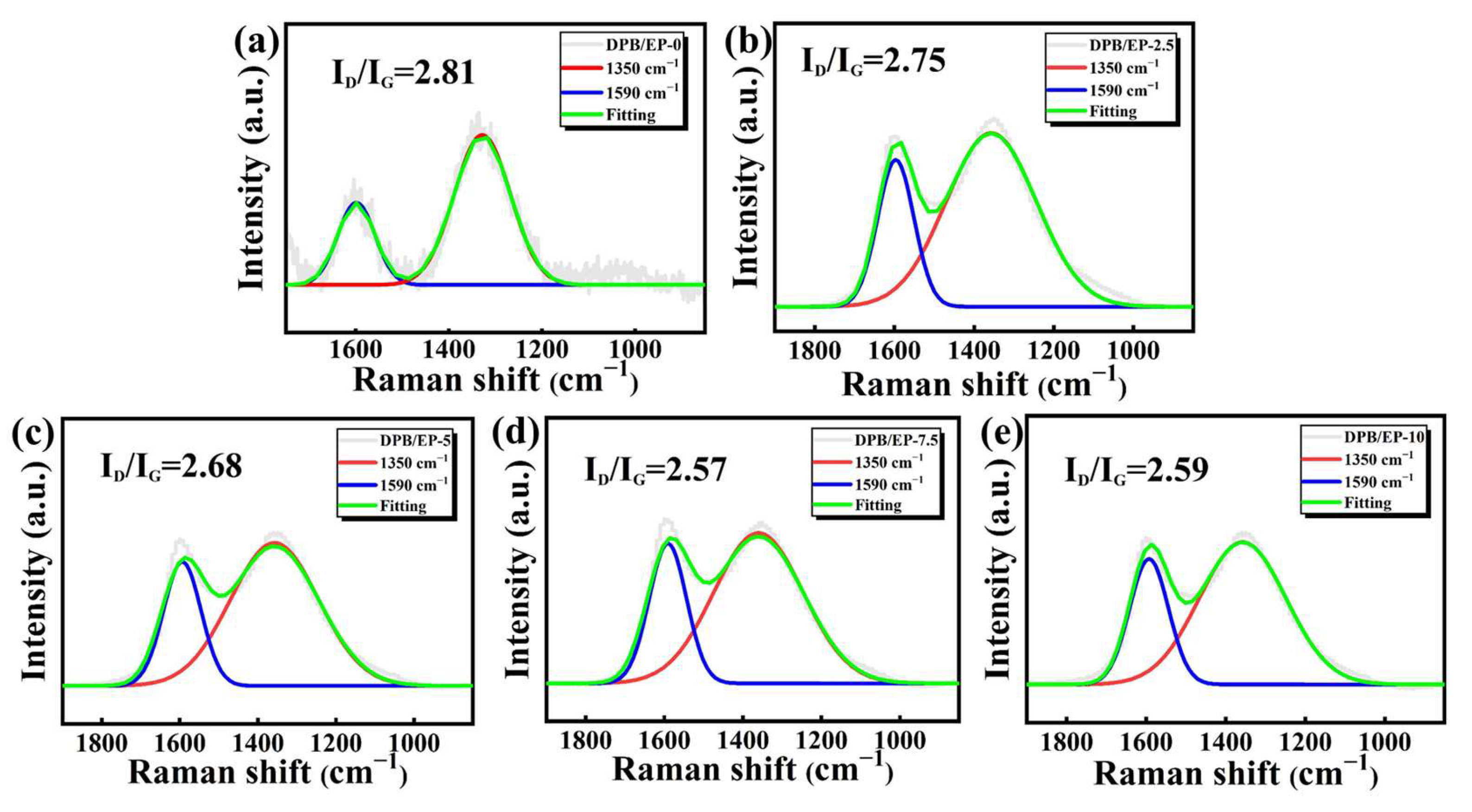
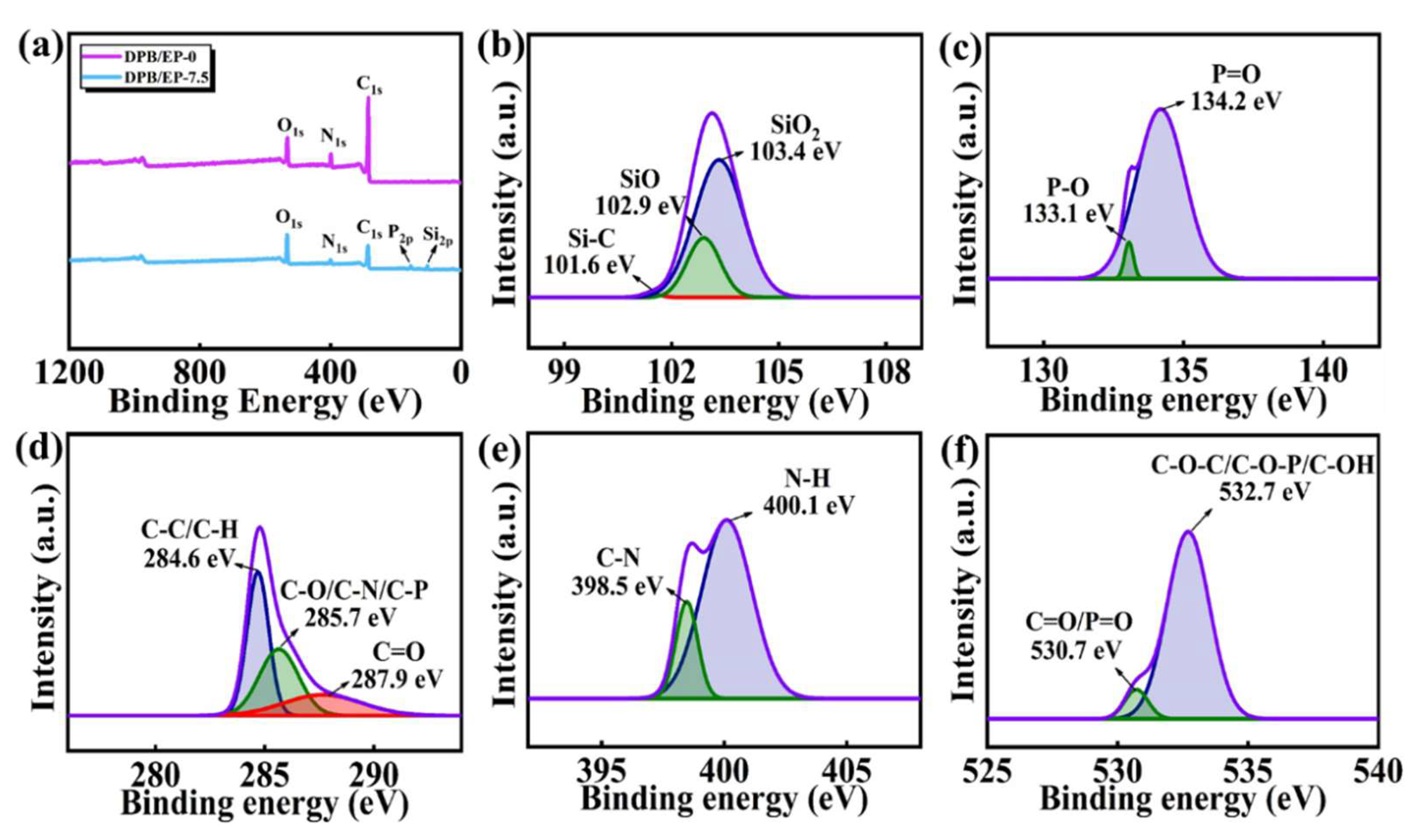

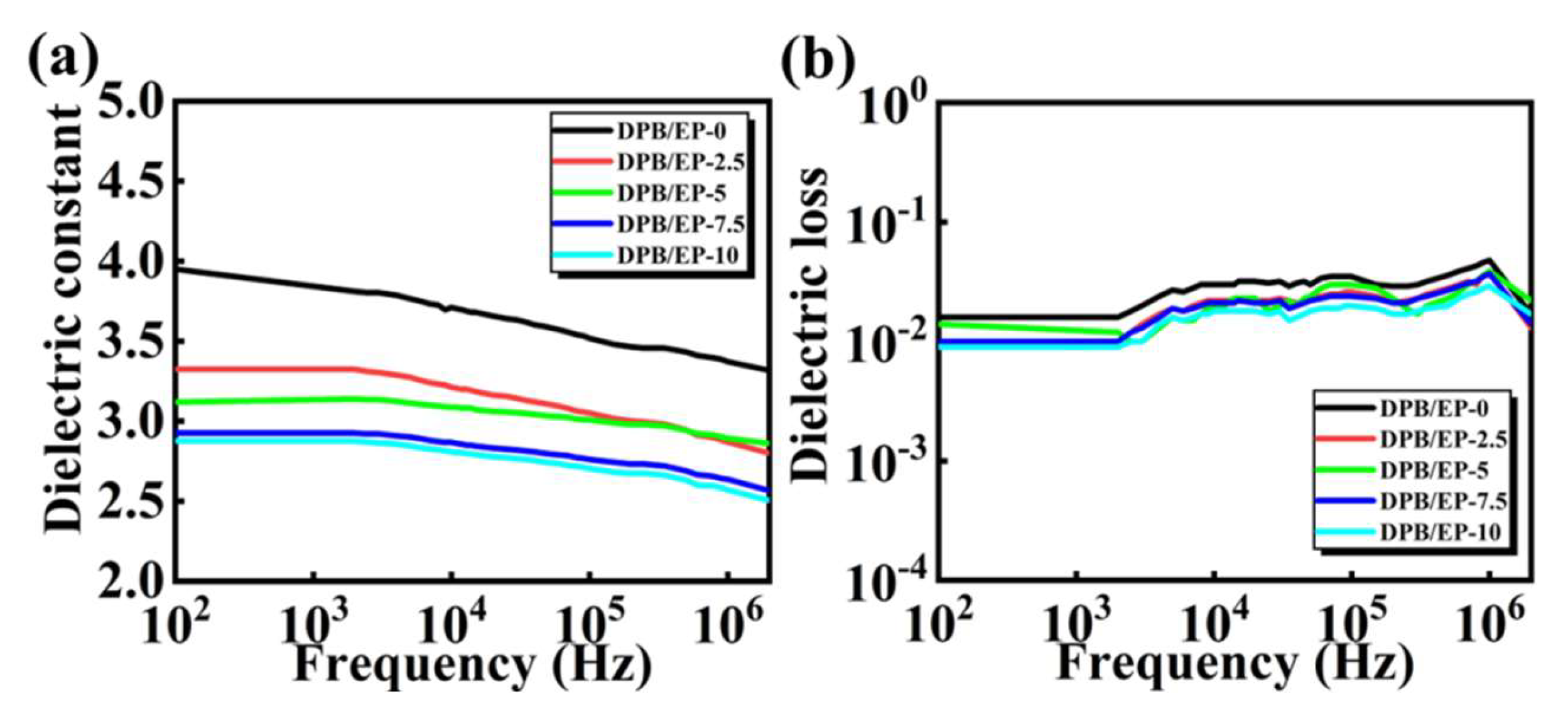
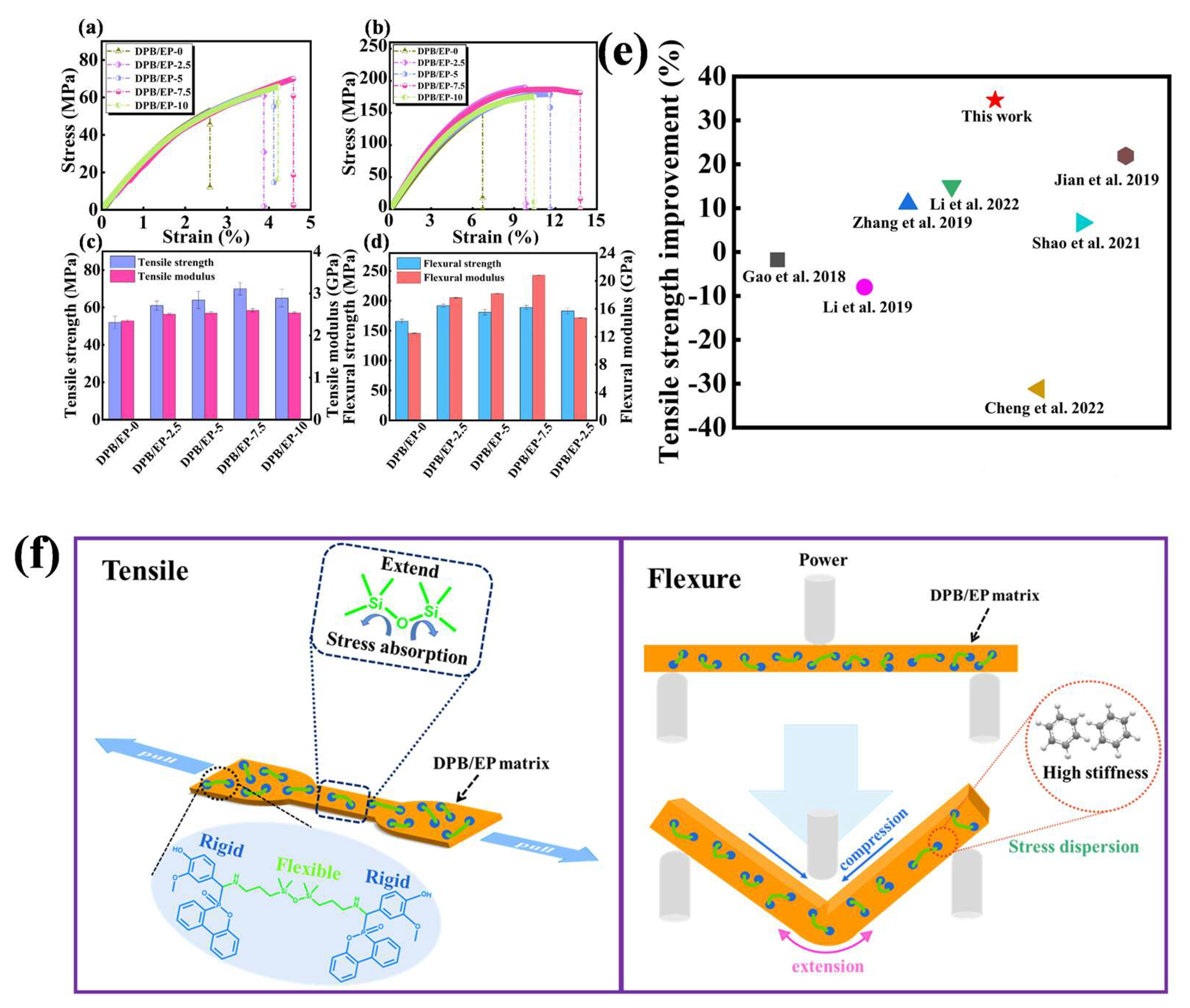
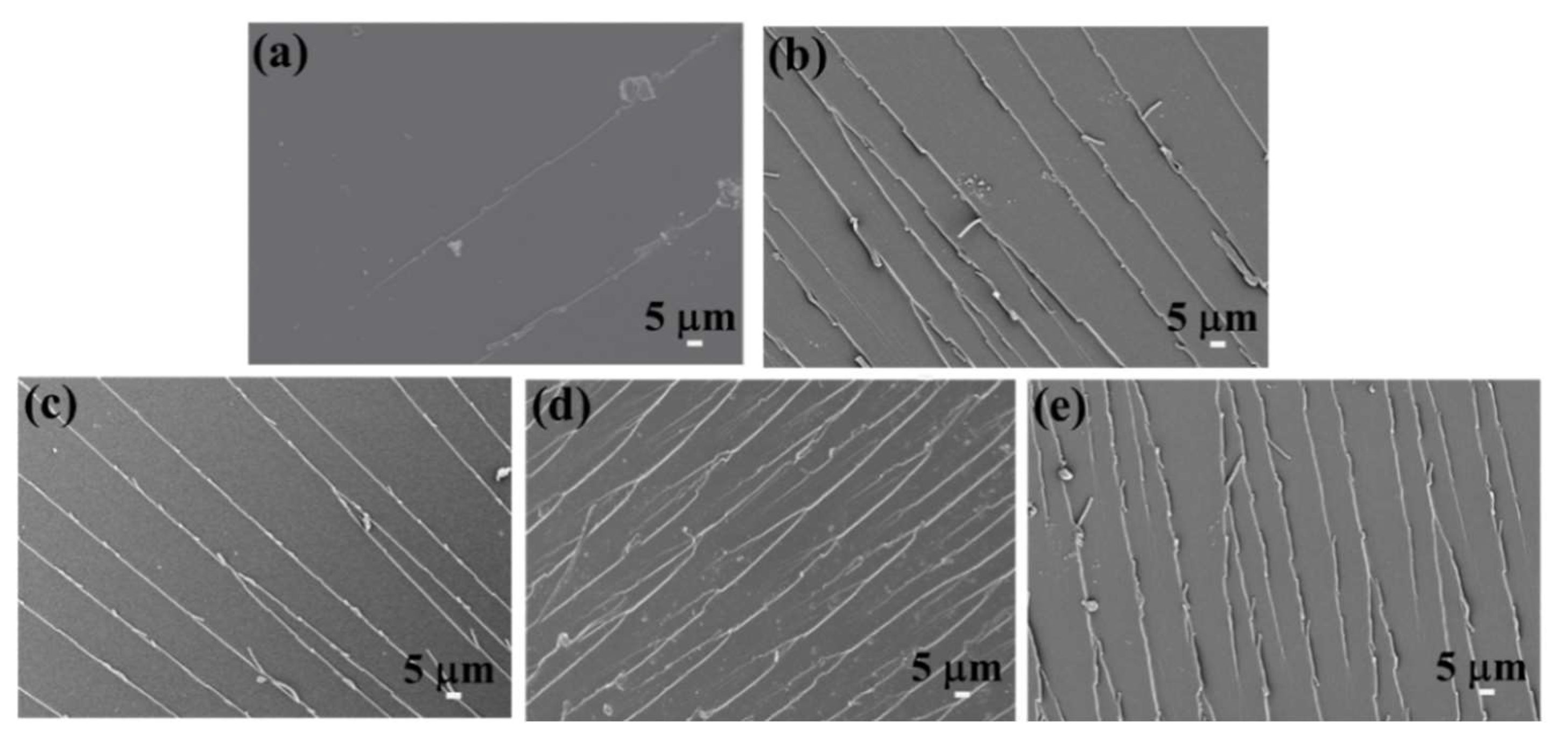

| Sample | T5% (°C) | Tmax (°C) | RC700 (wt%) |
|---|---|---|---|
| DPB/EP-0 | 379 ± 1.3 | 394 ± 1.4 | 17.2 ± 0.2 |
| DPB/EP-2.5 | 358 ± 1.5 | 385 ± 1.4 | 19.4 ± 0.3 |
| DPB/EP-5 | 356 ± 2.0 | 381 ± 1.9 | 19.4 ± 0.3 |
| DPB/EP-7.5 | 354 ± 1.8 | 378 ± 1.6 | 20.7 ± 0.2 |
| DPB/EP-10 | 353 ± 1.7 | 379 ± 1.8 | 19.4 ± 0.1 |
| Sample | TSP (m2) | THR (MJ/m2) | pHRR (kW/m2) | TTI (s) | MLR (g/s) |
|---|---|---|---|---|---|
| DPB/EP-0 | 26.1 | 155.5 | 1184 | 92 | 0.053 |
| DPB/EP-2.5 | 25.6 | 103.3 | 1008 | 76 | 0.042 |
| DPB/EP-5 | 25.0 | 101.1 | 984 | 77 | 0.040 |
| DPB/EP-7.5 | 23.6 | 85.4 | 724 | 72 | 0.032 |
| DPB/EP-10 | 24.7 | 93.8 | 884 | 69 | 0.035 |
| Sample | DPB (g) | E-51 (g) | DDM (g) |
|---|---|---|---|
| DPB/EP-0 | 0 | 100 | 25.0 |
| DPB/EP-2.5 | 2.5 | 100 | 25.0 |
| DPB/EP-5 | 5 | 100 | 25.0 |
| DPB/EP-7.5 | 7.5 | 100 | 25.0 |
| DPB/EP-10 | 10 | 100 | 25.0 |
Disclaimer/Publisher’s Note: The statements, opinions and data contained in all publications are solely those of the individual author(s) and contributor(s) and not of MDPI and/or the editor(s). MDPI and/or the editor(s) disclaim responsibility for any injury to people or property resulting from any ideas, methods, instructions or products referred to in the content. |
© 2023 by the authors. Licensee MDPI, Basel, Switzerland. This article is an open access article distributed under the terms and conditions of the Creative Commons Attribution (CC BY) license (https://creativecommons.org/licenses/by/4.0/).
Share and Cite
Li, D.; Lin, S.; Hao, J.; He, B.; Zhang, H.; Chen, M. A Rigid–Flexible and Multi-Siloxane Bridge Strategy for Toughening Epoxy Resin with Promising Flame Retardancy, Mechanical, and Dielectric Properties. Int. J. Mol. Sci. 2023, 24, 14059. https://doi.org/10.3390/ijms241814059
Li D, Lin S, Hao J, He B, Zhang H, Chen M. A Rigid–Flexible and Multi-Siloxane Bridge Strategy for Toughening Epoxy Resin with Promising Flame Retardancy, Mechanical, and Dielectric Properties. International Journal of Molecular Sciences. 2023; 24(18):14059. https://doi.org/10.3390/ijms241814059
Chicago/Turabian StyleLi, Dingsi, Shufeng Lin, Jiahui Hao, Baohan He, Huagui Zhang, and Mingfeng Chen. 2023. "A Rigid–Flexible and Multi-Siloxane Bridge Strategy for Toughening Epoxy Resin with Promising Flame Retardancy, Mechanical, and Dielectric Properties" International Journal of Molecular Sciences 24, no. 18: 14059. https://doi.org/10.3390/ijms241814059
APA StyleLi, D., Lin, S., Hao, J., He, B., Zhang, H., & Chen, M. (2023). A Rigid–Flexible and Multi-Siloxane Bridge Strategy for Toughening Epoxy Resin with Promising Flame Retardancy, Mechanical, and Dielectric Properties. International Journal of Molecular Sciences, 24(18), 14059. https://doi.org/10.3390/ijms241814059





